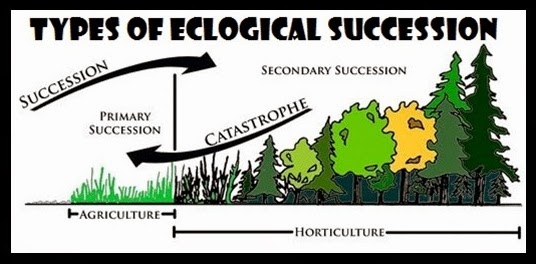TYPES OF ECOLOGICAL SUCCESSION
by Antonio C. Antonio
March 22, 2015
“What is ecological succession? Ecological succession is a natural
process of change in the species (fauna and flora) structure of an ecological
community over a period of time. The process begins with a few pioneering
animals and plants and a long-drawn sequence of morphology which ultimately
results to a climax community of living elements in an ecosystem. I
remember having written an article entitled “Ecological Succession” published
on http://antonantonio.blogspot.com/ before. In this article, I mentioned:
“There have been a few disturbances in the Philippine landscape in the last 25
years that could be considered as primary succession. Notable among which
is the eruption of Mt. Pinatubo in 1991 that covered most of Central Luzon with
ash. The subsequent lahar that changed the flow/stream of the river
systems in Tarlac, Pampanga and Zambales can also be included in this
disturbance regime. But if we visit these places now, there is hardly a
trace of Mt. Pinatubo’s devastating eruption. Other forms of disturbance
--- floods, landslides and storm surge --- can be considered secondary
succession since the presence of soil, which is the primary catalyst for
ecological succession, still exists.” (Antonio, 2014)
“There have been a few disturbances in the Philippine landscape in the
last 25 years that could be considered as primary succession. Notable
among which is the eruption of Mt. Pinatubo in 1991 that covered most of
Central Luzon with ash. The subsequent lahar that changed the flow/stream
of the river systems in Tarlac, Pampanga and Zambales can also be included in
this disturbance regime. But if we visit these places now, there is
hardly a trace of Mt. Pinatubo’s devastating eruption. Other forms of
disturbance --- floods, landslides and storm surge --- can be considered
secondary succession since the presence of soil, which is the primary catalyst
for ecological succession, is still present.”
(Antonio, 2014)
What are the types of ecological succession? They are primary and secondary
successions. Primary succession is of
biological and ecological succession of plant life, occurring in an environment
in which new substrate devoid of vegetation and usually lacking soil, such as a
lava flow or areas left from retreated glacier, is deposited. Primary succession develops on an area where
plant life never before existed such as areas covered by lava flow or newly
formed islands resulting from geological upliftment. After these new areas are colonized by plant
life, but disturbed, succession will now be secondary… therefore, secondary
succession. Secondary succession,
therefore, is a series of community changes which take place on a previously
colonized, but disturbed or damaged habitat.
Disturbances after the primary succession mostly come from or are the
results of anthropogenic (meaning: man-made) factors. Primary and secondary successions are the two
types of ecological succession.
Just my little thoughts…
(Please visit, like and share Pro EARTH Crusaders on
Facebook or follow me at http://antonantonio.blogspot.com/.)
REFERENCES:
Antonio, A. C., (2014). Ecological Succession (Part 2). Retrieved on the
22nd day of March 2015 from http://antonantonio.blogspot.com/2014/07/ecological-succession-part-2.html
Antonio, A. C,. (2014) Ecological Siccession. Retrieved on the 22nd
day of March 2015 from http://antonantonio.blogspot.com/search?q=ecological+succession

No comments:
Post a Comment